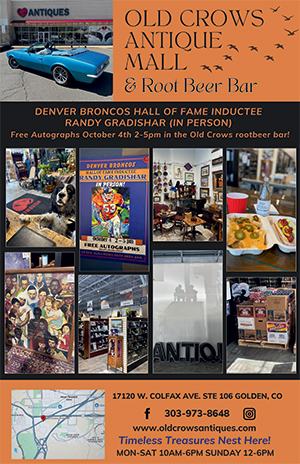McAllister House
Thank you so much for including the McAllister House Museum in your newsletter! This issue of the Mountain States Collector looks wonderful and we are grateful for the opportunity to be a part of it.
We would love to have you and your readers visit the McAllister House sometime soon! Our interpretation at the museum has changed a bit so the tour would be something new for everyone. Hope to see you soon! Deanna Traczek, Visitor Services Manager McAllister House Museum 423 N. Cascade Ave., Colorado Springs, CO 80903 (719) 635-7925 office, www.mcallisterhouse.org https://www.facebook.com/McAllisterHouseMuseum TOUR TIMES: Thurs.- Sat., 10:30 am, 12:30 pm & 2:30 pm Private Tours, Teas, and School Programs also available.
Irish Ancestors Found
Congrats on producing such a powerful account (in the Mountain States Collector) of the search for your Irish ancestors. I’m not sure how the locals in Colorado viewed the article, but your “cousins” in Ireland were enthralled with your account of the search. Next time you (or Mary or any members of your extended family) come to Ireland, I’ll make sure you get to see the place where your Sweeney ancestors once lived. Thankfully, the residents in that rural community today do not suffer the hardships (poverty, tyranny, lack of education, no employment opportunities, etc., etc.) that faced Owen and Patrick in the 19th century. But even so, the population continues to fall as most young people head to the cities for employment (maybe the “remote working” scenario brought about by Covid will change all that!).
In your Mountain States Collector article the description of the Sweeney background in Ireland, and of many of the historical events that befell this country which all influenced our shared history, was very accurate. Specifically, the article was correct in stating that the Sweeney branch in Sligo descended from a tribe of Scottish mercenaries (Gallowglasses) who prospered greatly in Ireland in the middle ages. However this family, also known as McSwyne, lost their vast estates and castles in Sligo to the army of Oliver Cromwell in 1650. Family members who survived the battle were “scattered” to other regions in the county.
Our more recent Sweeney story starts in the 1830s when a decision was taken to divide the family farm between 3 brothers: James (my direct ancestor), Owen (your ancestor) and John. The practice of subdividing farms in Ireland was common in the early 19th century. In the absence of viable emigration and other employment options, splitting farms became the only alternative for countless rural families in the Irish countryside. But these smaller and smaller properties became economically unviable, especially when the Great Famine hit the country after 1845. Post the famine, the subdividing practice was outlawed by the Landlords and emigration became the norm.
The Sweeney family farm was (and still is!) located in the townland of Crimlin, parish of Achonry, in south Co. Sligo. I was born there 67 years ago, but have lived most of my life in Dublin. My grandfather, Edward Sweeney, a returned American immigrant, purchased Owen’s share of the original property from the then owners, so in a sense merged two of the three units back to their original form. While Owen’s cottage no longer exists, it’s location is well known – my eldest brother well remembers the day in the 1950s when it was finally leveled. My younger brother still owns most of the farm which has been in the family possession for over two centuries.
It is now known that Owen Sweeney (1797-1878) had (at least) two children – your ancestor Patrick, and a daughter Mary. The very small family farm was barely capable of supporting even one family so all the children (bar one) would have been forced to emigrate or to marry a local landholder. There were simply no other options available in the mid to late 19th century in rural Ireland. In accordance with Irish social customs, a son usually stayed behind to retain the “valuable” farm in the family name and to care for his parents in their old age. In this case for whatever reason, that responsibility fell to Mary (1833-1908). She married a neighbor named Hunt, and had four daughters. Shortly afterwards, the farm was sold to my grandfather. . .
Kind Regards,
Ed Sweeney, Dublin, Ireland
Editor’s Note: Our family’s history is extensive as you may guess. Due to space limitations we could only provide parts of this correspondence. Nevertheless, our family wants Mr. Sweeney to know we are extremely grateful to him for sharing his research.













Follow Us